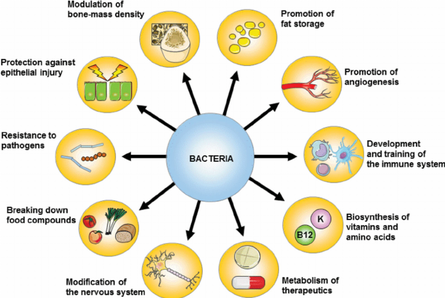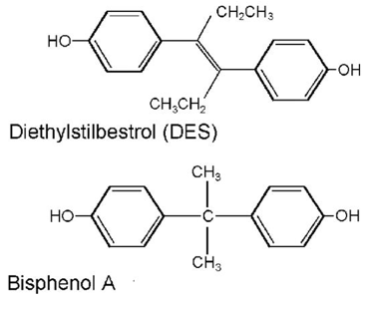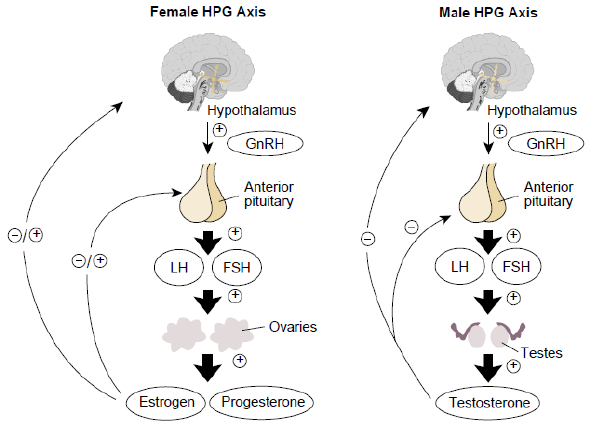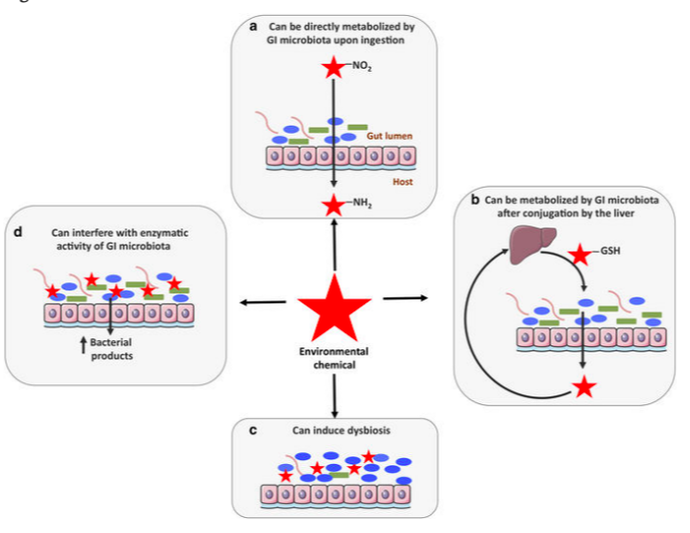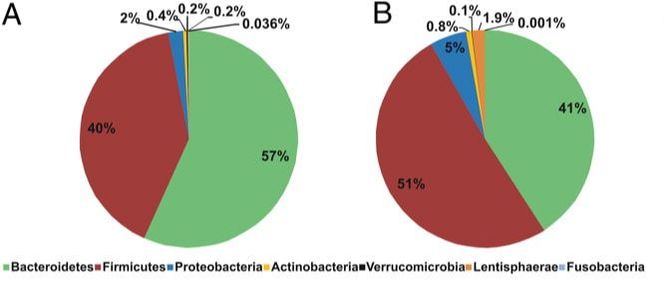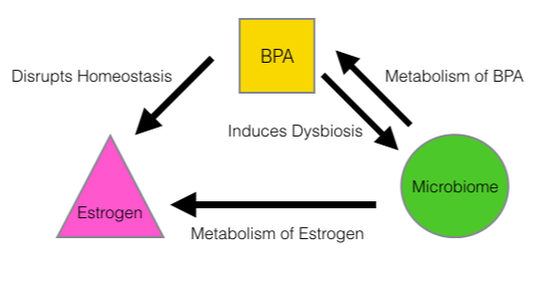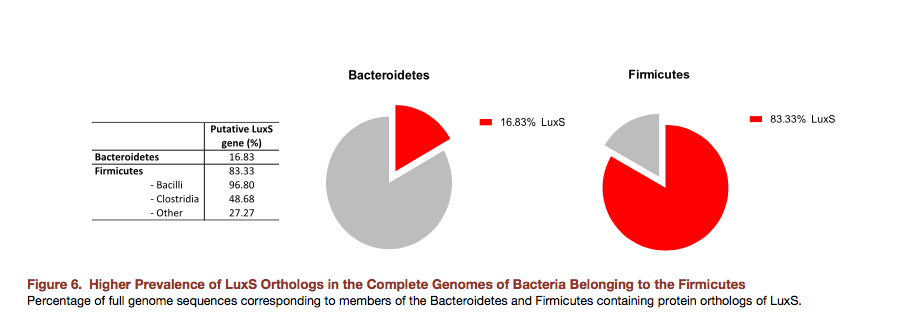The role of the microbiome in mediating the effect of Bisphenol A on the body.
Summary of premise
|
(17)
(20)
|
The microbiome holds a suite of enzymes whose substrates include stuffs from our diet, microbial metabolites, xenobiotics (chemicals in our environment), and endogenous signal molecules like estrogen. Like the liver, the enzymatic action on xenobiotics change the chemical properties of the substrate, making them more harmful or inactivating them. In addition food, hormones, microbial metabolites and biological signals, and even xenobiotics can cause a shift in the microbial community composition (16, 17). This shift can be positive or lead to negative change, dysbiosis. Dysbiosis is where our gut bacteria are no longer living in harmony with the host and this leads to sickness. The liver conjugates a sugar molecule to BPA so that it can be removed from the body. Through the action of b-glucuronidase and b-glucosidase, these substrates conjugated by the action of the liver are deconjugated and returned to their active fat soluble form. And are reabsorbed into the blood stream. The phyla who synthesize these enzymes are the majority members of the microbial community. Change in the composition of the microbiome community, through diet, has been shown to affect the concentration of estrogens excreted. Hence, the microbiome plays an important role in hormone balance in the body. Figure A is descriptive of a gut community associated with disease, while figure B describes a gut community associated with health. The difference is seen in overall diversity and a switch of the dominant phyla from Firmicutes to Bacteriodetes.
|
The core hypothesis is that BPA may cause dysbiosis by interfering with the communication of bacteria by interfering with AI-2 detection by the gut microbiome. This project is still in development and more hypotheses are being drafted about the mechanism of BPA's action in changing the composition of gut flora. If you are interested in learning more about the experiments that will be conducted or you find weaknesses in this hypothesis please navigate to the contact page to submit questions or comments.
Bibliography
1) ThomLaukens, D. Heterogeneity of the gut microbiome in mice: guidelines for optimizing experimental design. FEMS Microbiol Rev. 2016 Jan;40(1):117-32
2) Corrales, J. Global Assessment of Bisphenol A in the Environment Dose Response. 2015 Jul-Sep; 13(3): 1559325815598308.
3) Vom Saal, F.Evidence that bisphenol A (BPA) can be accurately measured without contamination in human serum and urine, and that BPA causes numerous hazards from multiple routes of exposure. Mol Cell Endocrinol. 2014 Dec; 398(1-2): 101–113.
4) Krishan, AV. Bisphenol-A: an estrogenic substance is released from polycarbonate flasks during autoclaving. Endocrinology. 1993 Jun;132(6):2279-86.
5) Huo, X. Bisphenol-A and Female Infertility: A Possible Role of Gene-Environment Interactions. Int J Environ Res Public Health. 2015 Sep; 12(9): 11101–11116.
6) Kong, Lu. Nickel Nanoparticles Exposure and Reproductive Toxicity in Healthy Adult Rats. International Journal of Molecular Sciences . 2014 Nov;15(11):21253-69.
7) Wang, J.The environmental obesogen bisphenol A promotes adipogenesis by increasing the amount of 11b-hydroxysteroid dehydrogenase type 1 in the adipose tissue of children. Int J Obes (Lond). 2013 Jul;37(7):999-1005.
8) Bertoli, S. Human Bisphenol A Exposure and the “Diabesity Phenotype”. Dose Response. 2015 Jul-Sep; 13(3): 1559325815599173.
9) Huang, Y. Prenatal Nonylphenol and Bisphenol A Exposures and Inflammation Are Determinants of Oxidative/Nitrative Stress: A Taiwanese Cohort Study. Environ. Sci. Technol., 2017, 51 (11), pp 6422–6429.
10) Malaisé, Y. Gut dysbiosis and impairment of immune system homeostasis in perinatally-exposed mice to Bisphenol A precede obese phenotype development. Scientific Reports, volume 7, Article number: 14472(2017).
11) Schulster, M. The role of estradiol in male reproductive function. Asian J Androl. 2016 May-Jun; 18(3): 435–440.
12) Konieczna A. Health risk of exposure to Bisphenol A (BPA). Rocz Panstw Zakl Hig. 2015;66(1):5-11.
13) Seachrist, D. A Review of the Carcinogenic Potential of Bisphenol A. Reprod Toxicol. 2016 Jan; 59: 167–182.
14) Leon, E. Bisphenol A Exposure and Behavioral Problems among Inner City Children at 7-9 Years of Age. Environ Res. 2015 Oct; 142: 739–745.
15) Giwercman, A. Estrogens and phytoestrogens in male infertility. Curr Opin Urol. 2011 Nov;21(6):519-26.
16) Piesl, B.Y. Dark matter in host-microbiome metabolomics: Tackling the unknowns–A review. https://doi.org/10.1016/j.aca.2017.12.034
17) Claus, S. The gut microbiota: a major player in the toxicity of environmental pollutants? npj Biofilms and Microbiomes. volume 2, Article number: 16003 (2016).
18) Kwa, M. The Intestinal Microbiome and Estrogen Receptor–Positive Female Breast Cancer. J Natl Cancer Inst. 2016 Aug; 108(8): djw029.
19) Dabek, M. Distribution of b-glucosidase and b-glucuronidase activity and of b-glucuronidase gene gus in human colonic bacteria. FEMS Microbiol Ecol 66 (2008) 487–495.
20) Claesson, M. Composition, variability, and temporal stability of the intestinal microbiota of the elderly. PNAS March 15, 2011. 108 (Supplement 1) 4586-4591.
21) Reddivari, L.Perinatal Bisphenol A Exposure Induces Chronic Inflammation in Rabbit Offspring via Modulation of Gut Bacteria and Their Metabolites. mSystems. 2017 Oct 10;2(5). pii: e00093-17.
22) Lai, KP. Bisphenol A alters gut microbiome: Comparative metagenomics analysis. Environ Pollut. 2016 Nov;218:923-930.
23) Javurek, A. Effects of exposure to bisphenol A and ethinyl estradiol on the gut microbiota of parents and their offspring in a rodent model. Gut Microbes. 2016; 7(6): 471–485.
24) Miao, M. Associations between Bisphenol A Exposure and Reproductive Hormones among Female Workers. Int J Environ Res Public Health. 2015 Oct 22;12(10):13240-50.
25) Baker, JM. Estrogen–Gut Microbiome Axis: Physiological and Clinical Implications. Maturitas. 2017 Sep;103:45-53.
26) Fuhrman, B. Associations of the Fecal Microbiome With Urinary Estrogens and Estrogen Metabolites in Postmenopausal Women. J Clin Endocrinol Metab. 2014 Dec; 99(12): 4632–4640.
27) Nakatsu, C. High-Fat Diet Induces Periodontitis in Mice through Lipopolysaccharides (LPS) Receptor Signaling: Protective Action of Estrogens. PLoS One. 2014; 9(10): e108924.
28) Deibel, ME. Estrogen modulates intestinal mucus physiochemical properties and protects against oxidant injury. J Trauma Acute Care Surg. 2015 Jan;78(1):94-9.
29) Beury-Cirou, A. At a Supra-Physiological Concentration, Human Sexual Hormones Act as Quorum-Sensing Inhibitors. 23 Dec. 2013. https://doi.org/10.1371/journal.pone.0083564.
30) Neuman, H. Microbial endocrinology: the interplay between the microbiota and the endocrine system. FEMS Microbiology Reviews, Volume 39, Issue 4, 1 July 2015, Pages 509–521.
31) Vanderberg, L.Bisphenol-A and the Great Divide: A Review of Controversies in the Field of Endocrine Disruption. Endocrine Reviews, Volume 30, Issue 1, 1 February 2009, Pages 75–95.
32) Thompson, J. Manipulation of the Quorum Sensing Signal AI-2 Affects the Antibiotic-Treated Gut Microbiota. 24 March 2015, Volume 10, Issue 11, p1861–1871.
2) Corrales, J. Global Assessment of Bisphenol A in the Environment Dose Response. 2015 Jul-Sep; 13(3): 1559325815598308.
3) Vom Saal, F.Evidence that bisphenol A (BPA) can be accurately measured without contamination in human serum and urine, and that BPA causes numerous hazards from multiple routes of exposure. Mol Cell Endocrinol. 2014 Dec; 398(1-2): 101–113.
4) Krishan, AV. Bisphenol-A: an estrogenic substance is released from polycarbonate flasks during autoclaving. Endocrinology. 1993 Jun;132(6):2279-86.
5) Huo, X. Bisphenol-A and Female Infertility: A Possible Role of Gene-Environment Interactions. Int J Environ Res Public Health. 2015 Sep; 12(9): 11101–11116.
6) Kong, Lu. Nickel Nanoparticles Exposure and Reproductive Toxicity in Healthy Adult Rats. International Journal of Molecular Sciences . 2014 Nov;15(11):21253-69.
7) Wang, J.The environmental obesogen bisphenol A promotes adipogenesis by increasing the amount of 11b-hydroxysteroid dehydrogenase type 1 in the adipose tissue of children. Int J Obes (Lond). 2013 Jul;37(7):999-1005.
8) Bertoli, S. Human Bisphenol A Exposure and the “Diabesity Phenotype”. Dose Response. 2015 Jul-Sep; 13(3): 1559325815599173.
9) Huang, Y. Prenatal Nonylphenol and Bisphenol A Exposures and Inflammation Are Determinants of Oxidative/Nitrative Stress: A Taiwanese Cohort Study. Environ. Sci. Technol., 2017, 51 (11), pp 6422–6429.
10) Malaisé, Y. Gut dysbiosis and impairment of immune system homeostasis in perinatally-exposed mice to Bisphenol A precede obese phenotype development. Scientific Reports, volume 7, Article number: 14472(2017).
11) Schulster, M. The role of estradiol in male reproductive function. Asian J Androl. 2016 May-Jun; 18(3): 435–440.
12) Konieczna A. Health risk of exposure to Bisphenol A (BPA). Rocz Panstw Zakl Hig. 2015;66(1):5-11.
13) Seachrist, D. A Review of the Carcinogenic Potential of Bisphenol A. Reprod Toxicol. 2016 Jan; 59: 167–182.
14) Leon, E. Bisphenol A Exposure and Behavioral Problems among Inner City Children at 7-9 Years of Age. Environ Res. 2015 Oct; 142: 739–745.
15) Giwercman, A. Estrogens and phytoestrogens in male infertility. Curr Opin Urol. 2011 Nov;21(6):519-26.
16) Piesl, B.Y. Dark matter in host-microbiome metabolomics: Tackling the unknowns–A review. https://doi.org/10.1016/j.aca.2017.12.034
17) Claus, S. The gut microbiota: a major player in the toxicity of environmental pollutants? npj Biofilms and Microbiomes. volume 2, Article number: 16003 (2016).
18) Kwa, M. The Intestinal Microbiome and Estrogen Receptor–Positive Female Breast Cancer. J Natl Cancer Inst. 2016 Aug; 108(8): djw029.
19) Dabek, M. Distribution of b-glucosidase and b-glucuronidase activity and of b-glucuronidase gene gus in human colonic bacteria. FEMS Microbiol Ecol 66 (2008) 487–495.
20) Claesson, M. Composition, variability, and temporal stability of the intestinal microbiota of the elderly. PNAS March 15, 2011. 108 (Supplement 1) 4586-4591.
21) Reddivari, L.Perinatal Bisphenol A Exposure Induces Chronic Inflammation in Rabbit Offspring via Modulation of Gut Bacteria and Their Metabolites. mSystems. 2017 Oct 10;2(5). pii: e00093-17.
22) Lai, KP. Bisphenol A alters gut microbiome: Comparative metagenomics analysis. Environ Pollut. 2016 Nov;218:923-930.
23) Javurek, A. Effects of exposure to bisphenol A and ethinyl estradiol on the gut microbiota of parents and their offspring in a rodent model. Gut Microbes. 2016; 7(6): 471–485.
24) Miao, M. Associations between Bisphenol A Exposure and Reproductive Hormones among Female Workers. Int J Environ Res Public Health. 2015 Oct 22;12(10):13240-50.
25) Baker, JM. Estrogen–Gut Microbiome Axis: Physiological and Clinical Implications. Maturitas. 2017 Sep;103:45-53.
26) Fuhrman, B. Associations of the Fecal Microbiome With Urinary Estrogens and Estrogen Metabolites in Postmenopausal Women. J Clin Endocrinol Metab. 2014 Dec; 99(12): 4632–4640.
27) Nakatsu, C. High-Fat Diet Induces Periodontitis in Mice through Lipopolysaccharides (LPS) Receptor Signaling: Protective Action of Estrogens. PLoS One. 2014; 9(10): e108924.
28) Deibel, ME. Estrogen modulates intestinal mucus physiochemical properties and protects against oxidant injury. J Trauma Acute Care Surg. 2015 Jan;78(1):94-9.
29) Beury-Cirou, A. At a Supra-Physiological Concentration, Human Sexual Hormones Act as Quorum-Sensing Inhibitors. 23 Dec. 2013. https://doi.org/10.1371/journal.pone.0083564.
30) Neuman, H. Microbial endocrinology: the interplay between the microbiota and the endocrine system. FEMS Microbiology Reviews, Volume 39, Issue 4, 1 July 2015, Pages 509–521.
31) Vanderberg, L.Bisphenol-A and the Great Divide: A Review of Controversies in the Field of Endocrine Disruption. Endocrine Reviews, Volume 30, Issue 1, 1 February 2009, Pages 75–95.
32) Thompson, J. Manipulation of the Quorum Sensing Signal AI-2 Affects the Antibiotic-Treated Gut Microbiota. 24 March 2015, Volume 10, Issue 11, p1861–1871.

